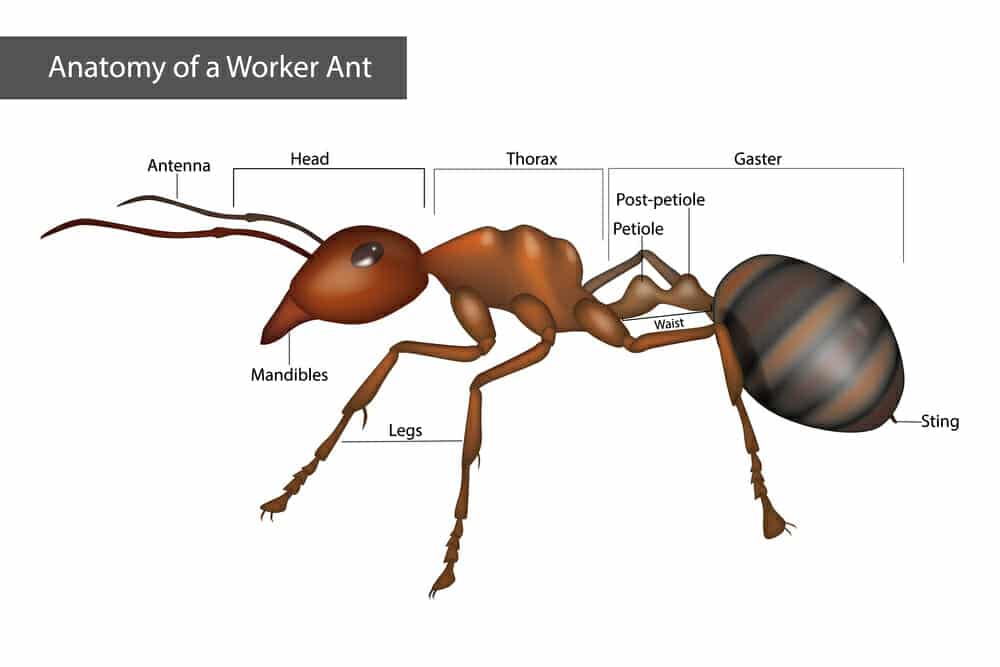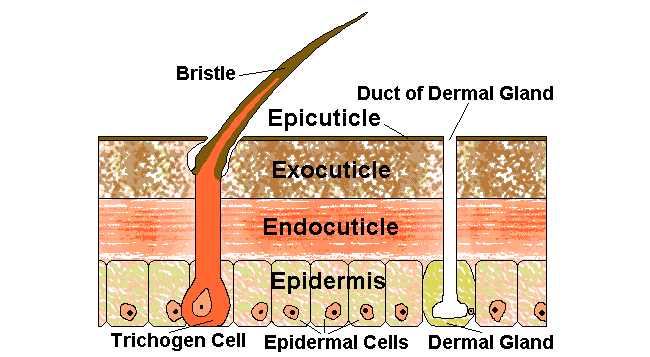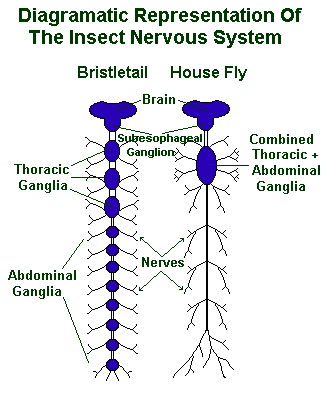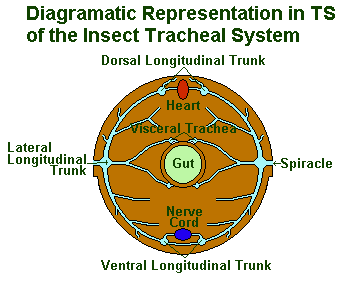Insect Anatomy
Insect Anatomy: Basic External and Internal Morphology and Functions
So, what makes an insect an insect?
Because of the great diversity of form exhibited by the insects, any introduction to insects anatomy like this is only going to be able to cover the basics.
Within each order and family, these familiar themes are replayed in myriad ways, creating what might seem to be a bewildering array of different body plans. A closer look will reveal the same basic plan in all insects, at least in the adult forms.

External insect morphology. The Insect Body
The insect body has a hard exoskeleton protecting a soft interior, and the bug anatomy can be divided into four main body parts:
Each of these is, in turn, composed of several smaller segments.
Insect body parts and anatomy diagram

The Insect Integument
The amazing success of the insects must, in part, lie with the incredible mixture of flexibility and strength of the integument (the part of an insect that makes up the hard exoskeleton) that allows insects their freedom of movement without loss of defense and protection.
It comprises three parts, the most visible of which is the outer cuticle and its attendant bristles and hairs. Below this is the epidermis and the basement membrane.
The Insect Cuticle
The cuticle is a relatively thin layer of non-cellular material that lines the external surface of the body, as well as lining the tracheae, the anterior and posterior sections of the alimentary canal, and parts of the reproductive system.
It is flexible, elastic, and white when first formed and stays this way in many larval forms. However, in most adults, it undergoes chemical processes that result in hardening and darkening, which are referred to as sclerotization.

The cuticle can be divided into two layers.
First, a thin outer layer called the epicuticle contains no chitin and is highly resistant to water and other solvents.
Secondly, and beneath this, is the much thicker procuticle, which can again be divided into two distinct layers of its own.
An outer exocuticle lies immediately below the epicuticle. And an inner endocuticle, which consists of a large number of layers of protein and chitin fibers, is laid down in a laminated pattern such that the individual strands in each layer cross each other, thus creating an extremely tough and flexible substance.
Below the cuticle lie the other two integument components: the epidermis, a single layer of secretory cells, and the basement membrane, which is an amorphous layer about 0.5 micrometers thick.
Insect Head
Much like our own, the insect head is the anteriormost part of the body. Sounds obvious, right? But this isn’t the case for all life on earth.

The insect head is a sclerotized structure containing vital sensory organs. It can be separated into two distinct regions:
- Anterior procephalon: the part of the head containing the eyes, the antennae, and the brain
- Posterior gnathocephalon: behind the procephalon and bears the mouthparts: mandibles, maxillae (pincer-like mouthparts), and labium (lower lip).
Let’s take a look at each section in a bit more detail.
Compound eyes and ocelli
Compound eyes are often large, bulging organs at the side of an insect’s head. They are comprised of tiny structures called ommatidia. Each ommatidia has a lens, used for focusing light, and pigments, or opsins, used for detecting color.
Unlike compound eyes, ocelli cannot produce complex environmental imagery. Instead, they are simple photoreceptors (light-detecting organs) that detect movements based on light levels.
Insects usually have three small ocelli, forming a triangle, on top of the head.
Antenna
Often a pair, the antennae are located at the front of an insect’s head.
They are sense organs that detect odors, sound frequencies, and water vapor levels in the air (genent.edu).
They are divided into three main parts:
- Scape: connects to the main head
- Pedicel: second segment
- Flagellum: all remaining segments
Mouthparts
Every insect will have mouthparts in one form or another. An insect’s diet will determine what mouthparts are present and their functions. A generalized insect mouthpart includes:
- Mandibles: strong and powerful, are used to cut the insect’s food or defend against predators.
- Maxillae: also referred to as pincers, their function is to hold food in the place. They also aid in taste.
- Labium: known as the lower lip, the labium protects other, more delicate, mouthparts.
Piercing and sucking
The mouthparts of true bugs (order Hemiptera) have evolved to a piercing and sucking lifestyle. These are insects with needle-like mouthparts used for stabbing and extracting fluids.
An elongated labia protects the modified hypodermic mandibles and maxillae. Saliva is transported through tubes within the maxillae to help digest food.
Siphoning
Siphoning insects, such as butterflies and moths, have no use for mandibles, as they primarily stick to a liquid diet of nectar.
The maxillae have evolved into a long proboscis, usually curled tightly under the insect’s head.
Insect Thorax
Moving down from the insect head, we reach the thorax. This is the locomotion unit of the insect.
The thorax comprises three sclerotized segments: the prothorax, mesothorax, and metathorax.
Each of these segments bears legs. Only the mesothorax and metathorax house the wings.
Let’s explore the thorax in more detail.
Wings
Many insects have wings to aid in movement. But not all insect wings are the same.
Some, such as dragonflies, are extended permanently to the side. Others, such as mayflies, keep their wings raised above their body.
Most insects, however, keep their wings safely tucked against their abdomen. This is to prevent wing damage while resting.
Insect wings are alive. They are packed with veins, tracheae, and nerves.
Veins
Veins help transport the insect equivalent of blood: hemolymph. It can be found throughout the thorax, most notably in the wings (pubmed.gov).
Hemolymph is pivotal to ensuring the wings remain functional. Actively circulating through wing veins, sensory structures that help with flight are maintained.
The structure of the veins within the wings contributes to the aerodynamic performance.
Legs
Legs can be found on each of the three segments of the thorax.

There are five parts to an insect leg:
- Coxa: point of contact with the thorax
- Trochanter: a joint-like structure connecting the femur and coxa
- Femur: typically the largest and most powerful region of the insect legs.
- Tibia: often the longest segment of the insect leg- is covered in hairs or spines that aid pollen collection or gripping.
- Tarsus: the final section of the insect leg is further divided into five sections, tarsomeres, usually ending with tiny claws or pads.
Insects do not just use their legs to walk. In some species, such as the water boatman, the legs have been modified to aid with swimming. Other species, such as the mole cricket, have evolved broad, flat legs to dig burrows.
Joints
Insects, like humans, have joints.
In fact, the term “arthropod” can be broken down into two words: arthro-, meaning joint, and pod- meaning foot.
The most visible joints on an insect are between the head, thorax, and abdomen.
Joints enable efficient locomotion, whether walking, jumping, or flying (ncbi.gov).
Insects can have hinge joints to allow and back and forth motion. They can also have ball and socket joints to allow for rotation. The joints are made of leathery chitin to retain flexibility and motility.
Insect Abdomen
The final of the three main segments of an insect is the abdomen.
The abdomen bears 11- 12 segments, containing the heart, digestive, and reproductive organs, including external genitalia.
Here, we’re briefly going to touch upon external genitalia.
The organs involved in copulation and egg-laying are collectively called external genitalia.
In females, the posterior region of the abdomen is modified into an egg-laying appendage known as the ovipositor. The ovipositor is long and sometimes confused with a stinger. The only function of the ovipositor is to lay eggs.
The primary function of male genitalia in insects is the insemination of females. This is achieved by clasping onto the female, developing spermatophores (a capsule of sperm), and depositing the spermatophore into the female’s genital tract (sciencedirect.com).
Related articles:
External insects morphology
The Insect Nervous System
The insect nervous system consists of a brain, resulting from the fusion of 3 pairs of ganglia.
Insect brain anatomy

A ganglion, plural ganglia, is a collection of neurons or nerve cells in a single place.
A pair of slender connective cords run side-by-side from the brain to the end of the insect’s abdomen and are known as the ventral nerve cord. These connective cords meet at intervals along the insect’s body at the ganglia.

In the most primitive design, one pair of ganglia per body segment. Thus, as the head comprises six fused body segments, it contains six pairs of ganglia. These are collected into two groups, each of 3 ganglia, the foremost of which is called the brain and the hindmost the subesophageal ganglion.
The ganglia function to coordinate the activities of the body segment they represent. In the most basic design, there are usually three thoracic ganglia and eight abdominal ganglia, but in most of the higher insects, some of the abdominal ganglia have been lost or become fused with those nearer the head.
Did you Know?
In the cockroach Blatta orientalis, there are three thoracic and only six abdominal ganglia; in the hornet Vespa crabro, there are only two thoracic ganglia and three abdominal ganglia.
This trend culminates in insects such as the common house fly, Musca domestica, where all the abdominal and thoracic ganglia have become fused into a single compound body ganglion.
Insect Tracheal System
Insects have no lungs!
Most insects breathe passively through their Spiracles (special openings in the side of their cuticle), and the air reaches the body using a series of smaller and smaller pipes called Tracheae (when their diameter is large and Tracheoles when their diameter is minimal).
Diffusion of gases is effective over small distances but not over larger ones. This is one of the reasons insects are all relatively small. Insects that do not have spiracles and tracheae, such as some Collembola, breathe directly through their skins and by diffusion of gases.
Some Diplura has eleven pairs, with four on the thorax. But in most of the ancient forms of insects – such as Dragonflies and Grasshoppers – there are two thoracic and eight abdominal spiracles.
The number of spiracles an insect has is variable between species. However, they always come in pairs, one on each side of the body, and usually one per segment.
In most of the remaining insects, there are fewer, so Hoverflies, Syrphidae, have only two pairs, both on the thorax and none on the abdomen.
While many Mosquito larvae and aquatic Beetle larvae have only one abdominal pair of spiracles, many insects have valves that allow them to close their spiracles, thus preventing water loss.
The tracheae are thin pipes that spread out from the spiracles to reach the whole body, with the smallest tracheoles contacting single muscle cells individually.
In some Collembola, each spiracle produces a tree branch, or tree root, of tracheae that are separate from those of other spiracles.
However, in most insects, the tracheal system is all linked through a series of longitudinal pipes called trunks and many more minor connections.

- Dorsal Longitudinal Trunk near the top or back of the insect’s body.
- Lateral Longitudinal Trunk running along the sides just in from the spiracles.
- Ventral Longitudinal Trunk running along the belly of the insect.
In many insects, particularly the larger Hymenoptera, the tracheae also link to a series of air sacs that can store air.
Interesting Fact
Most insects can use their body muscles to squeeze their tracheae and air sacs, thus forcing air out and drawing fresh air into the large tracheae to release muscular tension.
In insects like the dragonflies, this is a continuous action, but in others, it is irregular, as in cockroaches, or only occurs after active exercise, as in the larger Hymenoptera.
Hearing. Do Insects Have Ears?
Many, but not all, insects can hear sounds. Some even hear sounds that we can’t hear ourselves.
Insects hear through one of four different ways, the most common of which is the tympanum.
Tympanal organs always occur as paired organs. They are composed of a thin cuticular membrane (the tympanum) stretched across an air space of some sort and some form of connection to the nervous system.
In the Orthoptera (Grasshoppers and Crickets), tympanum are common, though situated in different places in different species, i.e., on the first thoracic segment in Grasshoppers and on the front legs in the Crickets.
Tympanal organs also occur in the Cicada (Cicadidae, Hemiptera) and some families of the Lepidoptera (i.e., Noctuidae, Geometridae, and Pyralididae).
The other three forms of insect hearing organs are:
- Johnston’s Organ, via the movement of hairs on the antennal scape, i.e., the Mosquito Aedes aegypti.
- Auditory Hairs occur on some Lepidopteran larvae as well as on some Orthoptera.
- The Pilifer is a unique auditory organ found only in the head of certain species of Hawk Moths of the subfamily Choerocampinae. Its optimum frequency is between 30 and 70 kHz, allowing it to hear the echolocation calls of many of the larger insectivorous bats.
Insects Digestive system
There are some basic life requirements that all animals need to survive: water, inorganic ions, and amino acids. Insects are no exception.
An insect’s digestive system comprises a foregut, a midgut, and a hindgut. Let’s take a look:

Foregut
The first zone of digestion, the foregut, is responsible for storing, grinding, and transporting food to the stomach or intestines.
Digestion begins in the mouth, where food is broken down by enzymes (amylase) in the salivary glands. The food is pushed through the pharynx and into the esophagus. Some insects, such as cockroaches, have a modified esophagus to store food.
Midgut
The midgut is the prime zone of digestion. Similarly to a mammalian stomach, most digestive enzymes are secreted here. Nutrients begin to get absorbed into the body.
However, the midgut is just used for digestion. Endocrine regulation also occurs here.
Hindgut
The primary function of the hindgut is to reabsorb specific organic ions, such as salts and amino acids, before waste products are excreted through the anus.
Salts and amino acids are pivotal in maintaining the osmotic pressure within the hemolymph.
Insect’s Circulatory system
Unlike mammalian circulatory systems, which are closed systems (arteries, veins, and capillaries), insects have an open circulatory system, lacking veins and arteries.

Body fluid, or hemolymph, flows freely through body cavities and appendages. The hemolymph transports nutrients around the body and expels waste. It is also responsible for the transport of hormones.
Hemolymph is vital for the insect’s defense. It has clotting properties and contains phagocytes (cells capable of engulfing bacteria) that consume pathogenic microbes.
A dorsal vessel runs longitudinally through the thorax and abdomen. The dorsal vessel is referred to as the heart (abdomen only).
The heart is divided into separate chambers. Contractions within specialized muscles, alary muscles, force a one-way flow of hemolymph until it empties at the brain and flows freely until it reaches the heart once more.
Insects Endocrine system
The endocrine system is one of the most important systems in an insect.
It is responsible for producing hormones that control molting, metabolism, reproduction, growth, and osmoregulation.
Hormones are chemical signals produced by and sent to cells in the body. Endocrine glands produce hormones and release them into the circulatory system.
The insect’s largest endocrine glands can be found in the prothorax (just behind the head). Here, ecdysteroids are formed. Closely related to steroids, these hormones promote the synthesis of chitin and molting.
Other structures within the endocrine system include:
- Neurohemal organs: store secretory products until signaled to release via the nervous system
- Neurosecretory cells: specialized nerve cells linking the nervous and endocrine system
- Internal organs: specific organs have hormone-producing cells, including reproductive and digestive organs.
Insects Reproductive system
An insect’s reproductive system is comparable to that of a vertebrate.
The reproductive system comprises sex organs, or gonads (testes and ovaries). Males produce sperm in the testes, and females develop eggs, or ova, in the ovaries.
Most insects display internal fertilization, male directly deposit sperm, in the form of a spermatophore, within a female during copulation.
Testes are located near the rear of the abdomen. They are subdivided into units called follicles. Sperm is produced in the follicles. Ducts transport mature sperm into a main ejaculatory duct and out of the male body via the aedeagus, or male copulatory organ.
Similarly to the testes, a female’s ovaries are divided into ovarioles, where the eggs are produced. Developing eggs pass down the ovariole, growing in size as they absorb the yolk.
Lateral oviducts transport the mature eggs from the ovaries to a genital chamber, bursa copulatrix. It is here where a male spermatophore is deposited. Fertilization and oviposition follow shortly after.
An egg ready to be laid is 100,000 times larger than when it was first produced.
Sense Of Touch
Touch is an extremely important sense to insects, and, like the smell, insects have developed many ways to detect a mechanical stimulus. These all involve some form of physical change in the receptor.
The most common are hairs attached to nerves which react when the hairs are moved, these are called Trichoid sensilla.
Another common type looks more like a drum, with something pressing up against the drum’s skin from beneath. These are called Campaniform sensilla.
Did you Know?
Mechanoreceptors detect not only the physical interaction with another body but also air movements, changes in air pressure, and changes in the stresses being applied to the insect’s cuticle.
Insects also use modified forms of the various sensory detectors described above to detect temperature and humidity changes and, in some cases, to detect infrared radiation, x-ray radiation, and the Earth’s magnetic field.
FAQs
What are the three parts of insects?
What is insect skin called?
What is the importance of insect morphology?
Final Thought
Well, I hope you have found this page useful. You could spend your entire life studying insect anatomy, a field that only seems to expand in depth the more attention you pay it, and using a microscope is the perfect place to start.
Disclaimer
Earthlife.net does not provide medical advice. We do our best to help users understand the science behind living beings; however, the content in the articles and on the website is not intended to be a substitute for consultation with a qualified expert. By interacting with the website and/or our email service, you agree to our disclaimer. Remember that you must consult a specialist before using any of the products or advice on the web.

